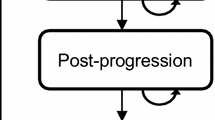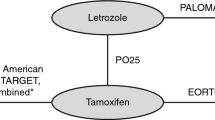Abstract
Background
This study evaluated the cost-effectiveness of anastrozole versus generic tamoxifen for primary adjuvant treatment of postmenopausal women with hormone receptor-positive (HR+) early breast cancer (EBC), from a US healthcare perspective.
Methods
A probabilistic Markov model was developed using the 5-year completed treatment analysis of the ATAC (‘Arimidex’, Tamoxifen Alone or in Combination) trial (ISRCTN 18233230) to project outcomes for anastrozole and tamoxifen to 25 years. Resource utilization data were obtained primarily from published literature and a physician survey (including expert opinion from ATAC Steering Committee members). Drug costs were taken from published wholesale acquisition costs (anastrozole $6.56/day, generic tamoxifen $1.33/day). Other unit costs ($US 2003–4) were from standard sources. Utility estimates of relevant health states, used to compute quality-adjusted life-years (QALYs), were collected using the standard gamble technique in a cross-sectional sample of 44 patients. Costs and benefits were discounted 3% annually.
Results
In a cohort of 1000 postmenopausal women with HR+ EBC, the model showed anastrozole treatment (versus tamoxifen) would lead to 257 QALYs gained (0.26 QALYs gained per patient), at an additional cost of $5.21 million over 25 years ($5,212 per patient). The estimated incremental cost-effectiveness ratio (ICER) of anastrozole compared with tamoxifen was $20,246 per QALY gained ($23,541 per life-year gained). Cost-effectiveness acceptability curves indicated a >90% probability that the cost per QALY gained with anastrozole would be <$50,000. Results were robust in a sensitivity analysis.
Conclusion
Anastrozole is a cost-effective alternative to tamoxifen for the primary adjuvant treatment of postmenopausal women with HR+ EBC.




Similar content being viewed by others
References
Early Breast Cancer Trialists’ Collaborative Group (1998) Tamoxifen for early breast cancer: an overview of the randomised trials. Lancet 351:1451–1467
Lamerato L, Havstad S, Gandhi S, Jones D, Nathanson D (2006). Economic burden associated with breast cancer recurrence: findings from a retrospective analysis of health system data. Cancer 106:1875–1882
Reddy P, Chow MS (2000) Safety and efficacy of antiestrogens for prevention of breast cancer. Am J Health Syst Pharm 57:1315–1322
ATAC Trialists’ Group (2005) Results of the ATAC (Arimidex, Tamoxifen, Alone or in Combination) trial after completion of 5 years’ adjuvant treatment for breast cancer. Lancet 365:60–62
The ATAC (Arimidex, Tamoxifen Alone or in Combination) Trialists’ Group (2003) Anastrozole alone or in combination with tamoxifen versus tamoxifen alone for adjuvant treatment of postmenopausal women with early-stage breast cancer: results of the ATAC (Arimidex, Tamoxifen Alone or in Combination) trial efficacy and safety update analyses. Cancer 98:1802–1810
Winer EP, Hudis C, Burstein HJ, et al (2005) American Society of Clinical Oncology technology assessment on the use of aromatase inhibitors as adjuvant therapy for postmenopausal women with hormone receptor-positive breast cancer: status report 2004. J Clin Oncol 23:619–629
Sonnenberg FA, Beck JR (1993) Markov models in medical decision making: a practical guide. Med Decis Making 13:322–338
Kamby C, Sengeløv L (1997) Pattern of dissemination and survival following isolated locoregional recurrence of breast cancer. Breast Cancer Res Treat 45:181–192
Moran M, Haffty B (2002) Local-regional breast cancer recurrence. Prognostic groups based on patterns of failure. Breast J 8:81–87
Stockler M, Wilcken NR, Ghersi D, et al (2000) Systematic reviews of chemotherapy and endocrine therapy in metastatic breast cancer. Cancer Treat Rev 26:151–168
Cook PJ, Doll R, Fellingham SA (1969) A mathematical model for the age distribution of cancer in man. Int J Cancer 4:93–112
Early Breast Cancer Trialists’ Collaborative Group (2001) Tamoxifen for early breast cancer. Cochrane Database Syst Rev (1):CD000486
Zhou Z, Redaelli A, Johnell O, et al (2004) A retrospective analysis of health care costs for bone fractures in women with early-stage breast carcinoma. Cancer 100:507–517
Sloss EM, Wickstrom SL, McCaffrey DF, et al (2004) Direct medical costs attributable to acute myocardial infarction and ischemic stroke in cohorts with atherosclerotic conditions. Cerebrovasc Dis 18:8–15
O’Brien JA, Caro JJ (2002) Direct medical cost of managing deep vein thrombosis according to the occurrence of complications. PharmacoEconomics 20:603–615
Hidlebaugh DA (2001) Relative cots of gynecologic endoscopy vs traditional surgery for treatment of abnormal uterine bleeding. Am J Managed Care Spec Iss:SP31–SP37
Gold MR, Siegel JE, Russell LB, et al. (eds) (1996) Cost-effectiveness in health and medicine. Oxford University Press, New York
Sorensen SV, Brown R, Benedict A, et al (2004) Patient-rated utilities in postmenopausal early breast cancer (EBC): a cross-country comparison. Value Health 7:641–642
Torrance GW (1986) Measurement of health state utilities for economic appraisal. J Health Econ 5:1–30
Tengs TO, Wallace A (2000) One thousand health-related quality-of-life estimates. Med Care 38:583–637
Garry R, Fountain J, Brown J, et al (2004) EVALUATE hysterectomy trial: a multicentre randomised trial comparing abdominal, vaginal and laparoscopic methods of hysterectomy. Health Technol Assess 8:1–154
Van Hout BA, Al MJ, Gordon GS, et al (1994) Costs, effects and C/E-ratios alongside a clinical trial. Health Econ 3:309–319
Briggs A (2001) Handling uncertainty in economic evaluations and presenting the results. In Drummond M, McGuire AM (eds). Economic Evaluation in Health Care: Merging Theory with Practice. Oxford University Press, Oxford, UK
Meltzer D (1997) Accounting for future costs in medical cost-effectiveness analysis. J Health Econ 16:33–64
Ubel PA, Hirth RA, Chernew ME, et al (2003) What is the price of life and why doesn’t it increase at the rate of inflation? Arch Intern Med 163:1637–1641
Hillner BE (2004) Benefit and projected cost-effectiveness of anastrozole versus tamoxifen as initial adjuvant therapy for patients with early-stage estrogen receptor-positive breast cancer. Cancer 101:1311–1322
Earle CC, Chapman RH, Baker CS, et al (2000) Systematic overview of cost-utility assessments in oncology. J Clin Oncol 18:3302–3317
Acknowledgements and funding
This study was conducted by MEDTAP International, Inc. (London, UK), with financial support from AstraZeneca (Macclesfield, UK). The contribution of patients who participated in the utility studies and the physician panel who provided estimated treatment patterns for use in the model is gratefully acknowledged.
Author information
Authors and Affiliations
Consortia
Corresponding author
Rights and permissions
About this article
Cite this article
Locker, G.Y., Mansel, R., Cella, D. et al. Cost-effectiveness analysis of anastrozole versus tamoxifen as primary adjuvant therapy for postmenopausal women with early breast cancer: a US healthcare system perspective. The 5-year completed treatment analysis of the ATAC (‘Arimidex’, Tamoxifen Alone or in Combination) trial. Breast Cancer Res Treat 106, 229–238 (2007). https://doi.org/10.1007/s10549-006-9483-6
Received:
Accepted:
Published:
Issue Date:
DOI: https://doi.org/10.1007/s10549-006-9483-6




